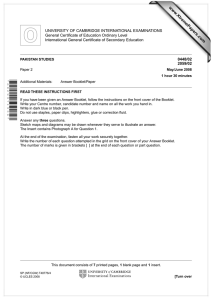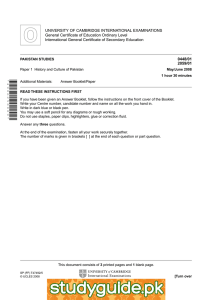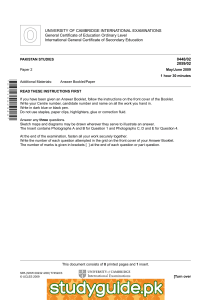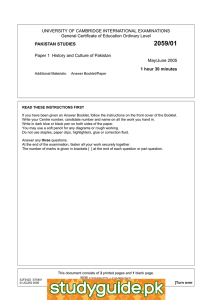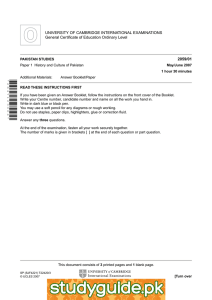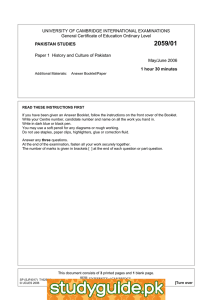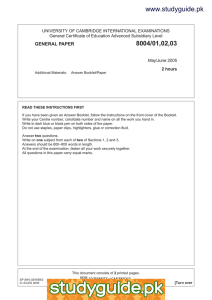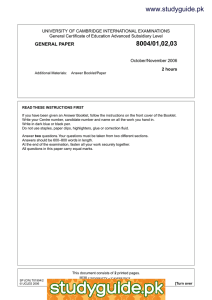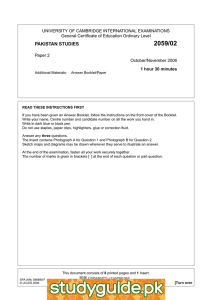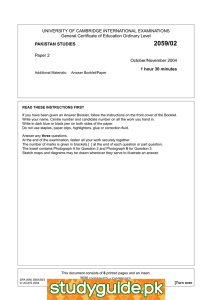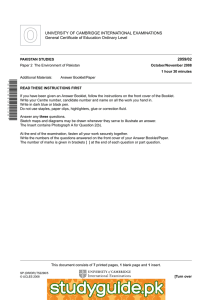UNIVERSITY OF CAMBRIDGE INTERNATIONAL EXAMINATIONS General Certificate of Education Ordinary Level
advertisement
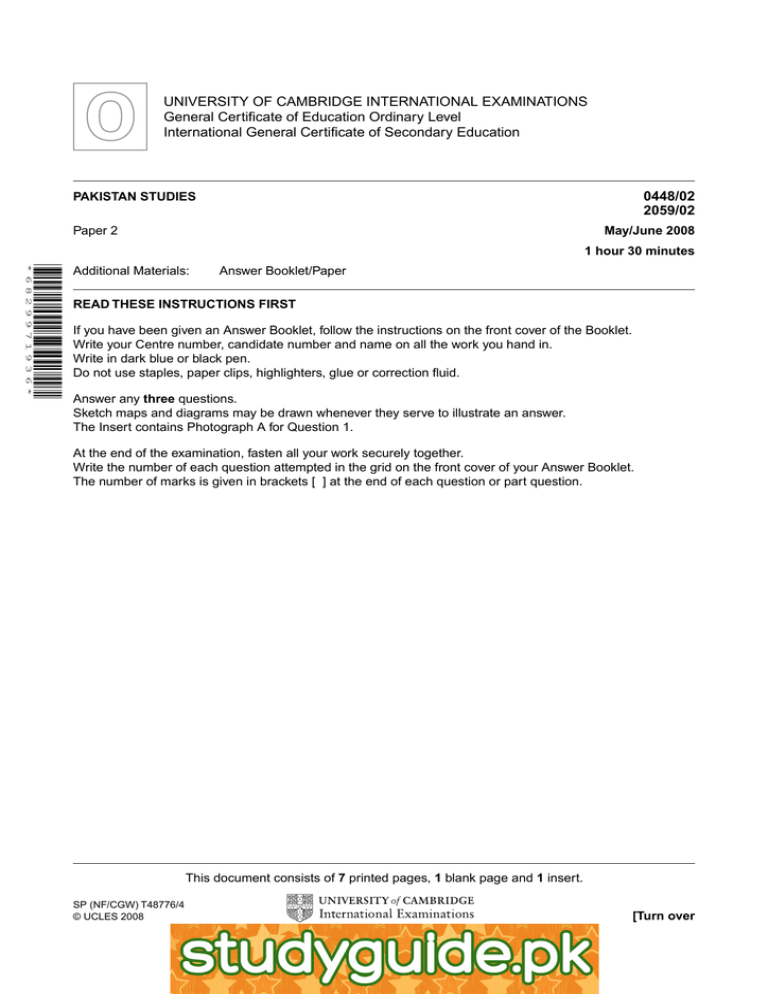
UNIVERSITY OF CAMBRIDGE INTERNATIONAL EXAMINATIONS General Certificate of Education Ordinary Level International General Certificate of Secondary Education 0448/02 2059/02 PAKISTAN STUDIES Paper 2 May/June 2008 1 hour 30 minutes *6829971936* Additional Materials: Answer Booklet/Paper READ THESE INSTRUCTIONS FIRST If you have been given an Answer Booklet, follow the instructions on the front cover of the Booklet. Write your Centre number, candidate number and name on all the work you hand in. Write in dark blue or black pen. Do not use staples, paper clips, highlighters, glue or correction fluid. Answer any three questions. Sketch maps and diagrams may be drawn whenever they serve to illustrate an answer. The Insert contains Photograph A for Question 1. At the end of the examination, fasten all your work securely together. Write the number of each question attempted in the grid on the front cover of your Answer Booklet. The number of marks is given in brackets [ ] at the end of each question or part question. This document consists of 7 printed pages, 1 blank page and 1 insert. SP (NF/CGW) T48776/4 © UCLES 2008 [Turn over www.xtremepapers.net 2 The Environment of Pakistan 1 (a) Study Photograph A (Insert) showing sugar cane cultivation. (i) Describe the scene. [4] (ii) What are the advantages and disadvantages of using tractors instead of animals for work on a farm? [6] (b) Yields from crops vary from year to year. Explain the reasons for this. [4] (c) (i) What work is done on the farm by these animals, other than that shown in the photograph? [3] (ii) What do these animals and other livestock on the farm produce that the farmer can use or sell? [3] (d) How can livestock farming be improved in Pakistan? © UCLES 2008 2059/02/M/J/08 www.xtremepapers.net [5] 3 2 (a) Study Fig. 1, a map of natural hazards in Pakistan. N Key Balochistan soil erosion tropical cyclones international boundary disputed international boundary provincial boundary Arabian Sea 0 km 400 Fig. 1 (i) Describe the distribution of soil erosion in Balochistan. [3] (ii) Explain why the dry climate of Balochistan increases the risk of soil erosion. [3] (iii) Where does eroded soil go to? [3] (iv) How can soil be protected in areas of low and unreliable rainfall? [4] (b) Study Fig. 1 again. (i) Which area is affected by tropical cyclones? [1] (ii) Describe the physical effects of tropical cyclones in this area. [5] (c) Heavy rain and thunderstorms affect business and industry in urban areas. Explain the advantages and disadvantages of the rain and storms. [6] © UCLES 2008 2059/02/M/J/08 www.xtremepapers.net [Turn over 4 3 (a) Study Fig. 2, a map of population density distribution in Sindh province. N Punjab Balochistan Y C INDIA E B B D A X Key coastline international boundary provincial boundary rivers city 0 100 km Arabian Sea Fig. 2 (i) Name the cities A, B and C. (ii) Name the desert D. (iii) Name the river E. [5] Explain the physical reasons for a high density of population in area Y. [4] Explain the low population density in area X. [3] (b) (i) (ii) © UCLES 2008 2059/02/M/J/08 www.xtremepapers.net 5 (c) Port Qasim is located 20 kilometres south-east of city A. (i) Give two reasons why this site was chosen for a new port. [2] (ii) Name the other port in Sindh to the west of city A. [1] (d) Iron ore, oil, and machinery are imported in large quantities at Port Qasim. (i) Give one large-scale use of each of these three. [3] (ii) Another large import is wheat. Name one country from which it is imported. [1] (iii) Explain why Pakistan will need to continue to import wheat. [2] (e) Name one dry port in Pakistan and explain why dry ports are needed to reduce the burden on sea ports. [4] © UCLES 2008 2059/02/M/J/08 www.xtremepapers.net [Turn over 6 4 (a) (i) Name two fishing ports on the coast of Balochistan. [2] (ii) Name two types of marine fish caught by fishermen. [2] (iii) Describe subsistence fishing methods. [3] (iv) Explain how these methods can be improved to make fishing commercial. [4] How can fish be stored and processed onshore? [3] (ii) Why is fish processing called ‘value-added’? [1] (iii) How does the poor infrastructure of Balochistan make development of the fishing industry difficult? [4] (b) (i) (c) Study Fig. 3, a graph comparing the production of marine and inland fisheries in Pakistan. 500 Marine 400 300 fish catch (1000 metric tonnes) 200 Inland 100 0 1960 1980 year 2000 Fig. 3 (i) Compare the changes shown in the graph. [3] (ii) Explain why more people are employed in inland fisheries than marine fishing. [3] © UCLES 2008 2059/02/M/J/08 www.xtremepapers.net 7 5 (a) Most hydro-electric power (hydel) schemes are in Northern Pakistan. (i) Name two large dams and the river on which each is built. [2] (ii) Why do the reservoirs of these dams hold very large quantities of water? [3] (b) Study Fig. 4, a diagram showing how hydro-electric power is made. A dam and reservoir transmission grid Fig. 4 Name the machine A, and explain how it uses the flow of water to make electricity. [2] (c) Study Fig. 5, a pie chart showing the different users of electricity in Pakistan. Other Office Domestic Farming Industry Fig. 5 (i) Which sector uses the largest percentage of electricity? (ii) State two more large users of electricity shown on the chart and explain what they use it for. [4] (iii) What problems are caused when the electricity supply to factories breaks down? (d) (i) [1] [4] Name two environmentally-friendly ways of making electricity other than hydro-electric power. [2] (ii) Explain why each of the two ways you have named could be used in Pakistan. (iii) Why is it important that more renewable energy schemes are developed in Pakistan? You may use your answers to part (c) and your own knowledge. [5] © UCLES 2008 2059/02/M/J/08 www.xtremepapers.net [2] 8 BLANK PAGE Copyright Acknowledgements: Question 1 Photograph A © Estate of Roland Strutt. Permission to reproduce items where third-party owned material protected by copyright is included has been sought and cleared where possible. Every reasonable effort has been made by the publisher (UCLES) to trace copyright holders, but if any items requiring clearance have unwittingly been included, the publisher will be pleased to make amends at the earliest possible opportunity. University of Cambridge International Examinations is part of the Cambridge Assessment Group. Cambridge Assessment is the brand name of University of Cambridge Local Examinations Syndicate (UCLES), which is itself a department of the University of Cambridge. 2059/02/M/J/08 www.xtremepapers.net
